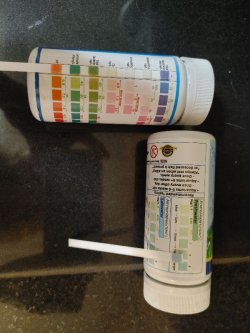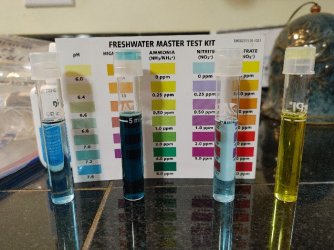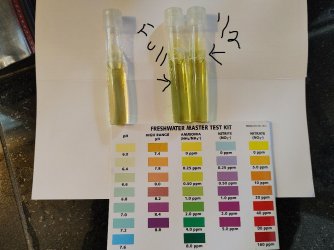Hello all,
I am looking for some help with what else......cycling. I am not a beginner as far as owning an aquarium, just been out of the hobby for a few years. Anyway, now that I am retired, I decided I wanted to get back into the hobby and bought a 55 gallon glass aquarium, with stand, canopy, tank covers and LED lighting. The fishless cycling was intriguing to me as I was used to setting up the aquarium, getting a couple of fish, once they were established, get some more and so on. Of course there was that cycling issue that had to be dealt with but back in the day, with the exception of my salt tank, I didn't have a way test water other than visually and scheduled water changes.
So, here I am. I purchased some API Quick Start and when I found out about Dr. Tim's ammoniun chloride, I ordered that. I followed the "recipe card" instructions and wrote down all the pH, NH4, Nitrate and Nitrite levels now for 6 days. the Quick Start was started a day or 2 before I added the ammonium chloride - that would make 8 days of cycling. I measure my levels using dip strips. Remembering the salt water testing using the vials, I thought these would be easier. For the past 6 days of measurements, nothing, and I mean NOTHING, has changed. ammonia stays at 1, pH around 7.2,carbonate 40, akalinity 80 and hardness at 75. I get NO reading for Cl, nitrate or nitrite. I finished my 4 oz bottle of Dr. Tim's today and I bought some Seachem Stability today. I had not been adding any nitrifying bacteria daily because Dr. Tim's didn't say it was necessary and all the YouTube videos did not make it clear that I needed to.
So..........am I just being impatient? Should I have added the nitrifying bacteria all along? When I feel my plastic decor, I can feel it has a slick surface so can I assume that is biofilm? I really!!!! do not want to drain this tank and start over, I get water from a well. I am ready to just buy some sacrificial feeder gold fish and do it the old fashioned way.
Thanks.
I am looking for some help with what else......cycling. I am not a beginner as far as owning an aquarium, just been out of the hobby for a few years. Anyway, now that I am retired, I decided I wanted to get back into the hobby and bought a 55 gallon glass aquarium, with stand, canopy, tank covers and LED lighting. The fishless cycling was intriguing to me as I was used to setting up the aquarium, getting a couple of fish, once they were established, get some more and so on. Of course there was that cycling issue that had to be dealt with but back in the day, with the exception of my salt tank, I didn't have a way test water other than visually and scheduled water changes.
So, here I am. I purchased some API Quick Start and when I found out about Dr. Tim's ammoniun chloride, I ordered that. I followed the "recipe card" instructions and wrote down all the pH, NH4, Nitrate and Nitrite levels now for 6 days. the Quick Start was started a day or 2 before I added the ammonium chloride - that would make 8 days of cycling. I measure my levels using dip strips. Remembering the salt water testing using the vials, I thought these would be easier. For the past 6 days of measurements, nothing, and I mean NOTHING, has changed. ammonia stays at 1, pH around 7.2,carbonate 40, akalinity 80 and hardness at 75. I get NO reading for Cl, nitrate or nitrite. I finished my 4 oz bottle of Dr. Tim's today and I bought some Seachem Stability today. I had not been adding any nitrifying bacteria daily because Dr. Tim's didn't say it was necessary and all the YouTube videos did not make it clear that I needed to.
So..........am I just being impatient? Should I have added the nitrifying bacteria all along? When I feel my plastic decor, I can feel it has a slick surface so can I assume that is biofilm? I really!!!! do not want to drain this tank and start over, I get water from a well. I am ready to just buy some sacrificial feeder gold fish and do it the old fashioned way.
Thanks.



 /www.drtimsaquatics.com/resources/library/quick-guide-to-fishless-cycling-wit-one-and-only/
/www.drtimsaquatics.com/resources/library/quick-guide-to-fishless-cycling-wit-one-and-only/

